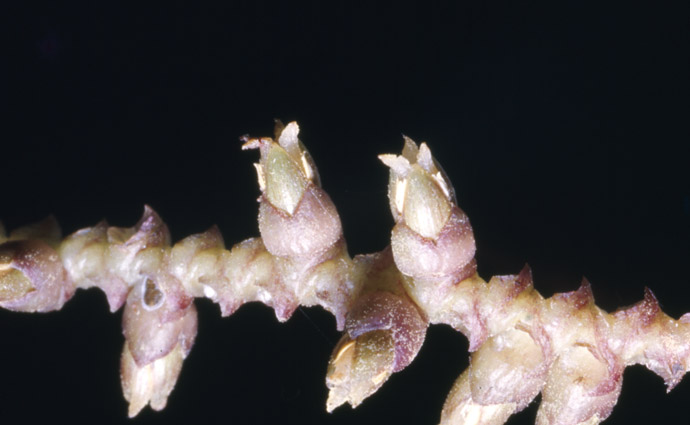- Acanthophoenix
- Acrocomia
- Actinokentia
- Actinorhytis
- Adonidia
- Aiphanes
- Allagoptera
- Ammandra
- Aphandra
- Archontophoenix
- Areca
- Arenga
- Asterogyne
- Astrocaryum
- Attalea
- Bactris
- Balaka
- Barcella
- Basselinia
- Beccariophoenix
- Bismarckia
- Borassodendron
- Borassus
- Brassiophoenix
- Burretiokentia
- Butia
- Calyptrocalyx
- Calyptrogyne
- Calyptronoma
- Carpentaria
- Carpoxylon
- Caryota
- Ceratolobus
- Ceroxylon
- Chamaedorea
- Chamaerops
- Chambeyronia
- Chelyocarpus
- Chuniophoenix
- Clinosperma
- Coccothrinax
- Cocos
- Corypha
- Cryosophila
- Cyphokentia
- Cyphophoenix
- Cyphosperma
- Daemonorops
- Deckenia
- Desmoncus
- Dictyocaryum
- Drymophloeus
- Dypsis
- Elaeis
- Eleiodoxa
- Eremospatha
- Eugeissona
- Euterpe
- Gaussia
- Geonoma
- Guihaia
- Hedyscepe
- Hemithrinax
- Howea
- Hyophorbe
- Hyospathe
- Hyphaene
- Iriartea
- Iriartella
- Itaya
- Jailoloa
- Johannesteijsmannia
- Juania
- Jubaea
- Jubaeopsis
- Kentiopsis
- Kerriodoxa
- Korthalsia
- Laccospadix
- Laccosperma
- Lanonia
- Latania
- Lemurophoenix
- Leopoldinia
- Lepidocaryum
- Lepidorrhachis
- Leucothrinax
- Licuala
- Linospadix
- Livistona
- Lodoicea
- Lytocaryum
- Manicaria
- Manjekia
- Marojejya
- Masoala
- Mauritia
- Mauritiella
- Maxburretia
- Medemia
- Metroxylon
- Myrialepis
- Nannorrhops
- Nenga
- Neonicholsonia
- Neoveitchia
- Nephrosperma
- Normanbya
- Nypa
- Oenocarpus
- Oncocalamus
- Oncosperma
- Orania
- Oraniopsis
- Parajubaea
- Pelagodoxa
- Phoenicophorium
- Phoenix
- Pholidocarpus
- Pholidostachys
- Physokentia
- Phytelephas
- Pigafetta
- Pinanga
- Plectocomia
- Plectocomiopsis
- Podococcus
- Pogonotium
- Ponapea
- Prestoea
- Pseudophoenix
- Ptychococcus
- Ptychosperma
- Raphia
- Ravenea
- Reinhardtia
- Retispatha
- Rhapidophyllum
- Rhapis
- Rhopalostylis
- Roscheria
- Roystonea
- Sabal
- Sabinaria
- Salacca
- Saribus
- Satakentia
- Satranala
- Schippia
- Sclerosperma
- Socratea
- Solfia
- Sommieria
- Syagrus
- Synechanthus
- Tahina
- Tectiphiala
- Thrinax
- Trachycarpus
- Trithrinax
- Veitchia
- Verschaffeltia
- Voanioala
- Wallaceodoxa
- Wallichia
- Welfia
- Wendlandiella
- Wettinia
- Wodyetia
- Zombia
- x Jubautia splendens
- ?? Acoelorrhaphe
- ?? Bentinckia
- ?? Brahea
- ?? Clinostigma
- ?? Colpothrinax
- ?? Copernicia
- ?? Cyrtostachys
- ?? Dictyosperma
- ?? Dransfieldia
- ?? Heterospathe
- ?? Hydriastele
- ?? Iguanura
- ?? Incertae sedis & excluded names
- ?? Loxococcus
- ?? Micronoma
- ?? Paripon
- ?? Pritchardia
- ?? Rhopaloblaste
- ?? Serenoa
- ?? Washingtonia

Distribution
Map uses TDWG level 3 distributions (https://github.com/tdwg/wgsrpd)
Widespread throughout the State. Elsewhere throughout Borneo, Java, Sumatra, Peninsular Malaysia, S. Thailand and Palawan. (Dransfield, J. 1997: The Rattans of Brunei Darussalam)A
Discussion
- C. javensis occurs in all major forest types except for mangrove, at altitudes from sea level to the tops of mountains. It is extremely polymorphic. The two most distinctive taxa in Brunei related to C. javensis have already been separated at the specific level, viz: C. tenompokensis and C. amplijugus. The other taxa in this complex appear to intergrade. (Dransfield, J. 1997: The Rattans of Brunei Darussalam)A
Etymology
- Of Java (Dransfield, J. 1997: The Rattans of Brunei Darussalam)A
Common Name
- Uwai Peladas (Dus., Br.), Uwai Podos (Dus.), Wi Anak (Ib.), Wi Peladas (Ib.) (Dransfield, J. 1997: The Rattans of Brunei Darussalam)A
Uses
- Produces an excellent cane for binding, to make fish traps and carrying baskets. (Dransfield, J. 1997: The Rattans of Brunei Darussalam)A
Description
- Extremely variable slender to very slender clustering rattan forming low thickets or climbing to 10 m or more; stem without sheaths 2-6 mm diam., with to 10 mm diam., internodes to 30 cm long, usually less. Sheaths bright green when fresh, frequently reddish tinged, somewhat striate, unarmed or sparsely to densely armed with horizontal spines to 5 mm; knee present; ocrea moderately conspicuous, to 10 mm, deep crimson when young, tattering with age. Flagellum to 1 m. Leaf ecirrate, very variable in form, in adult leaves always with the terminal pair of leaflets joined together for much of their length; petiole usually absent, rarely to 5 cm in some montane forms; leaflets 4-10 on each side of the rachis, grouped or more rarely subregular, lanceolate to spathulate, the lowermost 1-2 pairs often swept back across the stem, longest leaflets to 20 × 5 cm but usually much less, transverse veinlets conspicuous; young leaves tinged pink. Male and female inflorescences superficially similar with 2-5 partial inflorescences bearingcrimson rachillae ± at right angles. Ripe fruit ovoid, c. 12 × 8 mm, with a short beak and covered in 15-21 vertical rows of pale greenish white scales. Seed somewhat angular; endosperm homogeneous. Seedling leaf with 4 broad shiny leaflets. (Fig. 57). (Dransfield, J. 1997: The Rattans of Brunei Darussalam)A
Materials Examined
- BEL: Melilas, Bt.Batu Patam, Dransfield J. 6591. TEM: Johns 6509; Johns 6673A; Amo, Ashton A 289; Amo, Ashton A 487; Amo, Wong 1907; Amo, Bt.Belalong, Dransfield J. 7122; Amo, Bt.Belalong, Dransfield J. 7123; Amo, Bt.Belalong, Wong 1386; Amo, Bt.Retak, Wong 745; Amo, Bt.Retak, Wong 792; Amo, Bt.Retak, Wong 831; Amo, K.Belalong, Dransfield J. 6716; Amo, Kuala Belalong, Stockdale 37; Amo, Ulu Belalong, Dransfield J. 7388. TUT: Lamunin, Kpg.Lamunin, Wong 504; Rambai, Bt.Bahak, Coode 7022; Rambai, Tasek Merimbun, Bernstein 355. (Dransfield, J. 1997: The Rattans of Brunei Darussalam)A
- Log in to post comments

